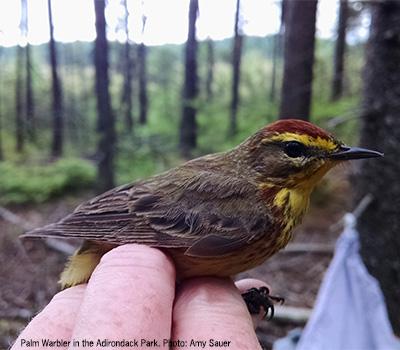Determining Sources of Mercury Contamination within Terrestrial Habitats in the Adirondack Park of New York State

Mercury is a global contaminant that adversely affects both humans and wildlife through neurological, immunological, and endocrinological mechanisms. After 50 years of studying the effects of mercury on birds, fish, and the environment, scientists have begun to understand how mercury moves through ecosystems and species at greatest risk. Past research has found that mercury exposure increases through the food chain, thus having the greatest effects on predators. Habitat also contributes to mercury exposure with wetlands and other wet habitats associated with elevated concentrations.
However, scientists have less information on songbird species and the types of conditions that affect their exposure risk. Using data from 81 songbird species, NSRC researchers focused on how habitat, climate, and food chain influenced mercury exposure across New York State. In sum, they found that all of these things mattered to mercury exposure in songbirds. While exposure could vary by region and species, wetlands were linked to increased mercury exposure. Furthermore, climate at sites also affected these processes with increased mercury exposure associated with warmer temperatures. Finally, an individual eating higher on the food chain was exposed to more mercury. Thus, a combination of factors contributes to mercury exposure across the songbird community, and local conditions are critical to determining adverse effects.
A missing component of this research is understanding how mercury enters these ecosystems and makes its way into a diverse community. Researchers know both distant sources of air pollution and local sources of water pollution contribute to exposure, and they are working to understand better the origins of exposure.
